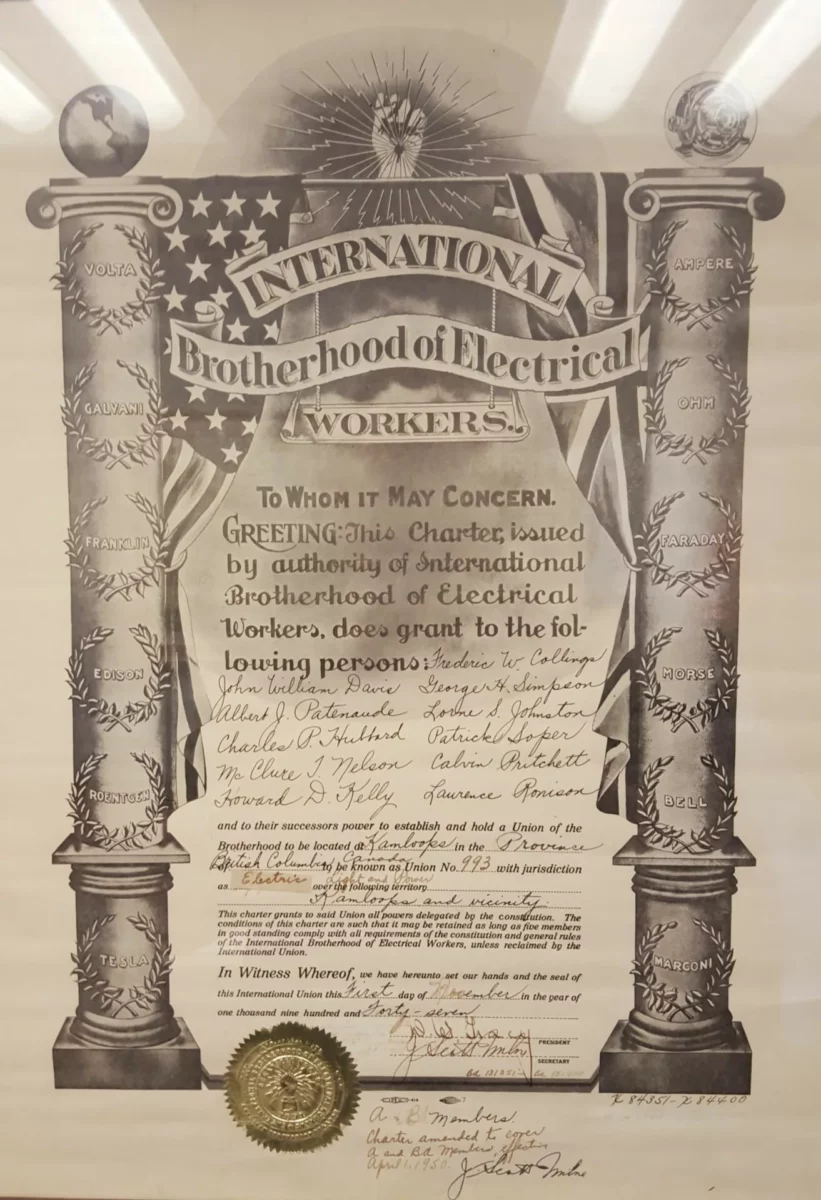
A Brief History of the IBEW in Canada and British Columbia
The Beginnings of the IBEW
The International Brotherhood of Electrical Workers (IBEW) was founded in St. Louis, Missouri, in 1891. The rapid growth of the electrical industry at that time came with harsh working conditions and significant safety risks. The IBEW was established to improve these conditions, ensure fair wages, and provide a collective voice for electrical workers. In 1890, a lineman named Henry Miller was elected as the first President of the Union. Brother Miller would ride the rails, following the work around the country and he was instrumental in organizing/chartering numerous new locals. A brief history of Brother Miller can be found here: IBEW: The Henry Miller Story (youtube.com) The mission of the IBEW quickly resonated beyond the borders of the United States, leading to its expansion into Canada.
Early Expansion into Canada
The IBEW’s presence in Canada began in 1899 with the chartering of Local 93 in Ottawa. As Canada industrialized in the early 20th century, the need for skilled electrical workers grew. The IBEW responded by establishing more local unions in major cities like Toronto, Montreal, and Vancouver, advocating for workers’ rights, safety, and fair wages.
Growth in British Columbia
British Columbia (BC), with its unique geography and booming industries, played a significant role in the expansion of the IBEW. The province’s rapid development in logging, mining, and later hydroelectric projects created a high demand for skilled electricians. The IBEW established its first local in BC, Local 213, in Vancouver in 1901. This local became a cornerstone for the union’s activities in the province.
Early 20th Century: Building the Foundation
Throughout the early 1900s, the IBEW in BC focused on organizing workers and improving their working conditions. The construction of major infrastructure projects, such as the BC Electric Railway and various hydroelectric dams, required skilled electrical workers. The IBEW played a critical role in these projects, ensuring that their members were trained and fairly compensated.
Mid-20th Century: Navigating Challenges and Expansion
The Great Depression and World War II brought challenges to the labor market in BC. However, the post-war era saw significant industrial growth and a surge in construction projects, including the expansion of the electrical grid and new hydroelectric projects. The IBEW in BC expanded its membership and influence, ensuring that its members were at the forefront of these developments.
During this period, the IBEW also began focusing on rural areas and smaller communities in BC and in 1947 IBEW Local 993 was chartered. The union recognized the importance of bringing electrical infrastructure to all parts of the province, which not only provided employment opportunities but also improved the quality of life for residents.
Late 20th Century: Technological Advancements and Modernization
The latter half of the 20th century brought technological advancements that transformed the electrical industry. The IBEW in BC adapted to these changes by emphasizing continuous education and training for its members. The introduction of new technologies, such as automation and renewable energy systems, required workers to acquire new skills and knowledge.
Training centers were established across BC, providing state-of-the-art facilities and programs to ensure that members remained at the cutting edge of the industry. This commitment to education has been a cornerstone of the IBEW’s mission in BC, ensuring that its members are not only skilled but also adaptable to the ever-evolving landscape of the electrical industry.
Advocacy and Social Responsibility
Beyond labor rights, the IBEW in BC has been a vocal advocate for broader social issues, including workplace safety, environmental sustainability, and equality. The union has been involved in numerous initiatives aimed at promoting safe work environments, reducing the carbon footprint of electrical projects, and supporting diversity and inclusion within the industry.
Modern Era: Strengthening Presence and Future Directions
Today, the IBEW is a significant force in BC, with thousands of members across the province. It continues to play a vital role in advocating for workers’ rights, ensuring high standards of training and safety, and adapting to new industry challenges.
The IBEW’s commitment to renewable energy projects, including wind and solar power installations, highlights its forward-looking approach. The union is also heavily involved in major infrastructure projects, such as the Site C hydroelectric dam and the expansion of the electrical grid to remote communities.
Conclusion
The history of the IBEW in Canada, and particularly in British Columbia, is a testament to the power of collective action and the importance of skilled labor in shaping the nation’s and the province’s industrial and economic landscape. From its early days in Vancouver to its current status as a leading labor organization, the IBEW has consistently championed the rights of electrical workers, ensuring that they are equipped, protected, and respected in their profession. As the industry evolves, the IBEW will undoubtedly continue to be a guiding force for its members and the broader community in British Columbia.

